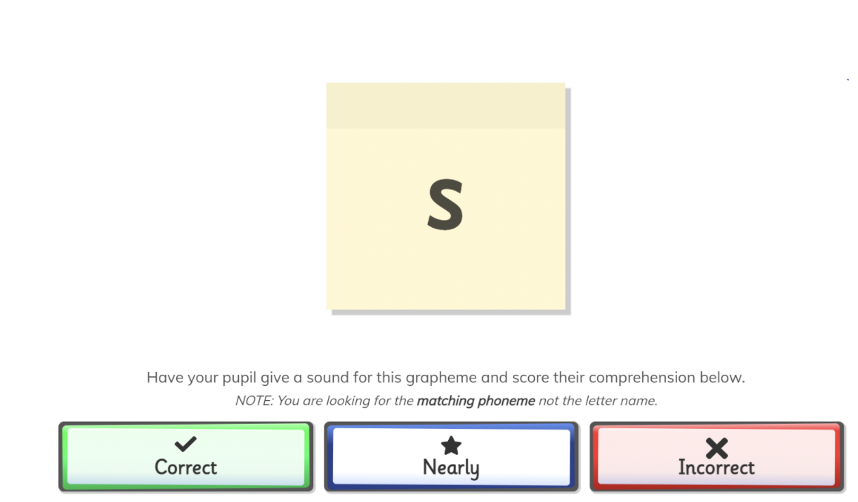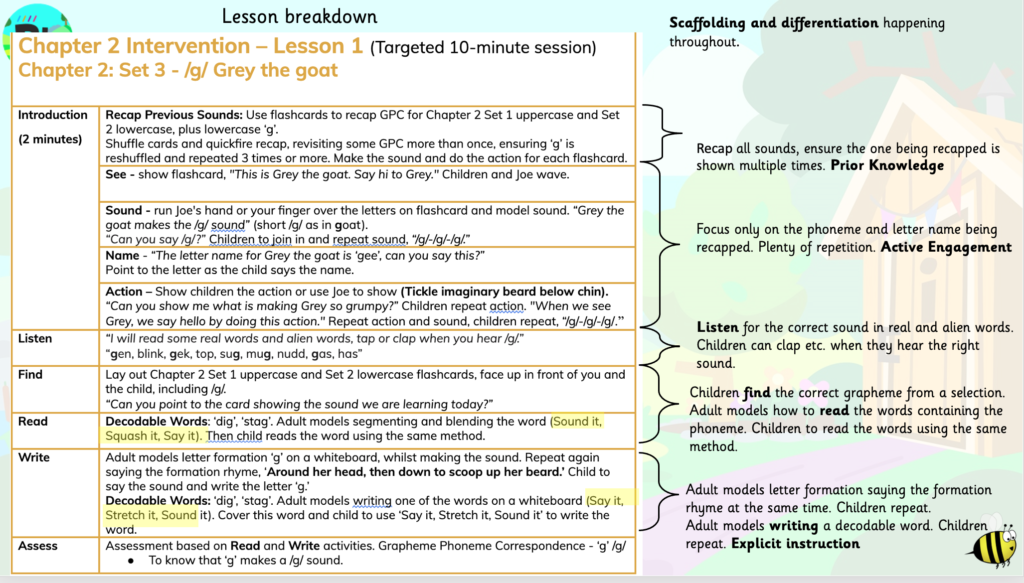What are the essentials of an evidence-based intervention?

Prior Knowledge
By activating prior knowledge, teachers help students become ready to assimilate new information. This cueing helps the learner associate new information with previously learned knowledge. Wendling, B.J. and Mather, N. (2008)
‘Donald Hebb who was influential in the area of neuropsychology famously said that “Cells that fire together, wire together” and, more formally, “any two cells or systems of cells that are repeatedly active at the same time will tend to become ‘associated,’ so that activity in one facilitates activity in the other”.

Active Engagement
Another key predictor of academic success is the amount of time the student is actively engaged in learning (Greenwood, Horton and Utley, 2002). When the pupil is an active participant, attention and focus is increased as they are thinking about the task in hand. Wendling, B.J. and Mather, N. (2008)
In Phonics Shed we use: recall, imitating, actions, songs, reading and writing to keep engagement high.

Explicit instruction – The task is clearly explained, modelled or demonstrated by the teacher, practiced by the learner with frequent feedback and then practiced independently. The pupil is then clear on what is expected of them because it the skill has been practiced with guidance ready for it to be mastered. Wendling, B.J. and Mather, N. (2008)
Scaffolding instruction – provides the bridge between what the student knows and the student is learning. This also links to Bruner’s theory and term of “scaffolding” at the same time as the three-phased learning approach.
Differentiated instruction – based on the individual pupil’s needs.

How do I identify pupils for intervention?
Assessment
Often, we can easily identify pupils who need intervention from formative assessment in day-to-day Phonics lessons. This might be from the way they respond or perform in the activities or answers to questions. If possible, this would call for a same-day intervention to keep them on track
We can also identify gaps through summative assessment. Our platform provides a teacher assessment tool that allows tracking of children’s learning. At the relevant points in the children’s progression, teachers can use our flashcard assessment tool to screen children against the grapheme-phoneme pairs they have learned.

Data Reporting
Teachers can view a summary of attainment for children in their classes at any time. The grid shows a snapshot of competence versus individual grapheme-phoneme pairs and allows for easy identification of children needing further support as well as whole-class review lessons needed. (See our consolidation plans)

How do I know if intervention is right for my pupils?
When only a small group need to consolidate a particular GPC or related skill, use our intervention program, designed for small group or 1:1 consolidation of learning.
These interventions can be run during the consolidation weeks to fill gaps or alongside the main phonics scheme as an additional small group activity for those at risk of falling behind.
The flow diagram indicates whether consolidation or intervention plans are needed.

These intervention plans are designed to be quick and last just 10 minutes.
They require minimal resources and can be easily adapted to be covered more than once if further consolidation is needed. There is one intervention lesson for every GPC covered from Chapter 2 to 4b and several for each Element in Chapter 1.
The Chapter 1 interventions can be used to support children who are struggling with the foundation skills even as they progress with other chapters of the main scheme.

How to make intervention lessons count

Share the learning intention and outcome with the children
“Today we are recapping the /g/ sound and how to write the letter ‘g.’ By the end of this lesson I want you to be able to say the letter name, sound and be able to write the letter ‘g’ too.”
Recap prior learning
All previous sounds, with the focus sound included a few times to ensure repetition. Recap focus letter name and action Gives the children a positive start to the session as they experience success early on.
Explicit teaching
Plenty of talk/ guidance and repetition. Demonstration of active listening and importance of eye contact.
Sound – “This sound is /g/, can you say /g/?”. Letter name – “This is a ‘jee’ can you say ‘jee’?”
Model, model, model
Letter formation – “Around her head and then down to scoop up her beard.” Word reading and word writing.


Your turn
In order for the assessment to be accurate, it is important that children complete the ‘read’ and ‘write’ section independently. Plenty of encouragement and praise here.
Putting it into practice
During the whole-class/group phonics lesson, children are given the chance to use their new skills : • by reading decodable texts through the use of ‘Additional suggestions for continuous provision’
References
Wendling, B.J. and Mather, N. (2008). Essentials of Evidence-Based Academic Interventions. [online] Google Books. John Wiley & Sons
Further Reading
Improving reading: Interventions, strategies, and Common Core connections (7th ed.) by J. L. Johns and Lenski, S. D. (2019)
